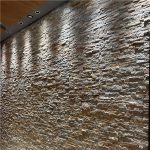Introduction
Faux cultured stone, also known as synthetic stone veneer, has become increasingly popular in the construction and design industry in recent years. This versatile material offers a cost-effective and lightweight alternative to natural stone, while still providing the aesthetic appeal and durability of traditional stone. In this comprehensive guide, we will explore the various aspects of faux cultured stone, including its composition, benefits, installation process, maintenance requirements, and design possibilities.
Composition of Faux Cultured Stone
Faux cultured stone is typically made from a combination of cement, aggregates, and iron oxides, which are molded and colored to resemble natural stone. The manufacturing process involves casting the mixture into molds that replicate the texture and appearance of various types of stone, such as limestone, slate, or granite. The resulting product is lightweight, yet durable, making it an ideal choice for both interior and exterior applications.
Benefits of Faux Cultured Stone
There are several advantages to using faux cultured stone in construction and design projects. One of the main benefits is cost savings, as synthetic stone veneer is generally more affordable than natural stone. Additionally, its lightweight nature makes installation easier and more efficient, reducing labor costs and time. Faux cultured stone is also available in a wide range of colors, shapes, and sizes, allowing for greater design flexibility and customization options. Furthermore, synthetic stone veneer is resistant to moisture, mold, and mildew, making it a low-maintenance and long-lasting material.

Installation Process
The installation of faux cultured stone is a relatively straightforward process that can be completed by experienced DIYers or professional contractors. The first step is to prepare the surface by cleaning and applying a weather-resistant barrier, such as building paper or a moisture barrier. Next, the stone veneer panels are laid out and trimmed to fit the desired area, taking care to stagger the joints for a more natural appearance. The panels are then secured to the surface using a polymer-modified mortar or adhesive, ensuring a strong bond. Finally, any gaps or seams are filled with mortar or grout, and the surface is cleaned to remove any excess material.
Maintenance Requirements
While faux cultured stone is a durable and low-maintenance material, it still requires some care to ensure its longevity and appearance. Regular cleaning with a mild detergent and water can help remove dirt, debris, and stains from the surface of the stone veneer. It is also important to inspect the stone periodically for any signs of damage or wear, such as cracks, chips, or discoloration, and repair them promptly to prevent further issues. Additionally, applying a sealant or protective coating to the stone can help enhance its resistance to moisture and UV rays, prolonging its lifespan.
Design Possibilities
Faux cultured stone offers endless design possibilities for both residential and commercial projects. Whether used as an accent wall in a living room, a fireplace surround in a cozy den, or an exterior facade on a commercial building, synthetic stone veneer can add a touch of elegance and sophistication to any space. The variety of colors, textures, and shapes available allows for creative combinations and unique patterns that can complement a wide range of architectural styles and design aesthetics. From rustic and traditional to modern and contemporary, faux cultured stone can enhance the visual appeal and character of any interior or exterior setting.
Conclusion
Faux cultured stone, or synthetic stone veneer, is a versatile and cost-effective alternative to natural stone that offers a wide range of benefits and design possibilities. DIY cultured stone backsplash of cement, aggregates, and iron oxides, combined with a molding process that replicates the texture and appearance of natural stone, makes it a durable and lightweight material suitable for various applications. Whether used for interior accent walls, exterior facades, or fireplace surrounds, faux cultured stone can enhance the aesthetic appeal and value of any space. With proper installation and maintenance, synthetic stone veneer can provide years of beauty and durability, making it a popular choice for homeowners, designers, and contractors alike.
